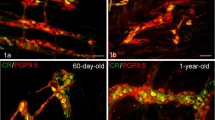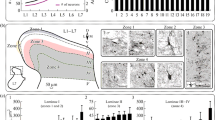Abstract
Immunoreactivity for calbindin was found in nerve endings with irregular laminar shapes in the rat esophagus. In the myenteric ganglia, laminar endings of a range of sizes formed a complex network and appeared to lie at the surface of the ganglion. The myenteric ganglia that contained nerve endings were most abundant in the upper portion of the eosphagus, their number decreasing orally to anally. Calbindin-immunoreactive nerve cell bodies were scattered throughout the esophagus. Laminar terminals were found in the connective tissue of the lamina propria immediately beneath the epithelium and in the muscularis mucosae. Occasional nerve branches formed a network of aborizing endings that surrounded part of the submucosal arterioles. Immunoreactive nerve endings in the mucosa and submucosa were present only in the upper part of the cervical esophagus. Unilateral vagotomy caused a remarkable decrease in the number of the myenteric ganglia containing the calbindin-immunoreactive laminar endings after 15 days or survival; in some of ganglia, the laminar structures disappeared and nerve endings showing weak immunoreactivity had an indistinct appearance, so that the outline of the ganglia became obscure. In operated rats at 24 days, the number of innervated ganglia was about half that in normal rats. However, there was no change in the morphology and the occurrence of the immunoreactive laminar structures in the mucosa and submucosa after denervation. The results show that many of the laminar endings that are immunoreactive for calbindin in the myenteric ganglia are derived from the vagus nerve. Thus, the calbindin-immunoreactive nerve endings with laminar expansions that are found in the rat eosphageal wall could be sensory receptors.
Similar content being viewed by others
References
Andressen C, Blumcke I, Celio MR (1993) Calcium-binding proteins: selective markers of nerve cells. Cell Tissue Res 271:181–208
Andrew BL (1956) The nervous control of the cervical oesophagus of the rat during swallowing. J Physiol (Lond) 134:729–740
Andrew BL (1957) Activity in afferent nerve fibers from the cervical oesophagus. J Physiol (Lond) 135:54–55
Antral M, Freund TF, Polgar E (1990) Calcium binding proteins, parvalbumin-and calbindin-D 28k-immunoreactive neurons in the rat spinal cord and dorsal root ganglia: a light and electron microscopic study. J Comp Neurol 295:467–484
Baimbridge KG, Celio MR, Rogers JH (1992) Calcium-binding proteins in the nervous system. Trends Neurosci 15:303–308
Bieger D (1993) The brainstem esophagomotor network generator: a rodent model. Dysphagia 8:203–208
Carr PA, Yamamoto T, Karmy G, Baimbridge KG, Nagy JI (1989) Parvalbumin is highly colocalized with calbindin D28k and rarely with calcitonin gene-related peptide in dorsal root ganglia neurons of rat. Brain Res 497:163–170
Cecio A, Califano G (1967) Neurohistological observation on the oesophageal innervation of rabbit. Z Zellforsch 83:30–39
Celio MR (1990) Calbindin D-28k and parvalbumin in the rat nervous system. Neuroscience 35:375–475
Christensen J (1984) Origin of sensation in the esophagus. Am J Physiol 246:G221-G225
Clarke GD, Davison JS (1975) Tension receptors in the oesophagus and stomach of the rat. J Physiol (Lond) 244:41–42
Clerc N, Mei N (1983) Vagal chemoreceptors located in the lower oesophageal sphincter of the cat. J Physiol (Lond) 336:487–498
Collman PI, Trenblay L, Diamant NE (1992) The distribution of spinal and vagal sensory neurons that innervate the esophagus of the cat. Gastroenterology 103:817–822
Dogiel AS (1899) Über den Bau der Ganglien in den Geflechten des Darmes und der Gallenblase des Menschen und der Säugetiere. Arch Anat Physiol Leipzig, Anat Abt (Jg 1899): 130–158
Fryscak T, Zenker W, Kantner D (1984) Afferent and efferent innervation of the rat esophagus. Anat Embryol 170:63–70
Hirst GDS, Holman ME, Spence I (1974) Two types of neurons in the myenteric plexus of duodenum in the guinea-pig. J Physiol (Lond) 236:303–326
Hudson LC, Cummings JF (1985) The origins of innervation of the esophagus of the dog. Brain Res 326:125–136
Iyer V, Bornstein JC, Costa M, Furness JB, Takahashi Y, Iwanaga T (1988) Electrophysiology of guinea-pig myenteric neurons correlated with immunoreactivity for calcium binding proteins. J Auton Nerv Syst 22:141–150
Kashiba H, Senba E, Ueda Y, Tohyama M (1990) Calbindin D28k-containing splanchnic and cutaneous dorsal root ganglion neurons of the rat. Brain Res 528:311–316
Khurana RK, Petras JM (1991) Sensory innervation of the canine esophagus, stomach, and duodenum. Am J Anat 192:293–306
Kolossow NG, Milochin AA (1963) Die afferente Innervation der Ganglien des vegetativen Nervensystems. Z Mikrosk Anat Forsch 70:426–464
Kuramoto H, Furness JB, Gibbins IL (1990) Calbindin immunoreactivity in sensory and autonomic ganglia in the guinea pig. Neurosci Lett 115:68–73
Lawrentjew BJ (1929) Experimentell-morphologische Studien über den feineren Bau des autonomen Nervensystems. II. Über den Aufbau der Ganglien der Speiseröhre nebst einigen Bemerkungen über das Vorkommen und die Verteilung zweier Arten von Nervenzellen im autonomen Nervensystem. Z Mikrosk Anat Forsch 18:233–262
Leander S, Brodin E, Håkanson R, Sundler F, Uddman R (1982) Neuronal substance P in the esophagus. Distribution and effects on motor activity. Acta Physiol Scand 115:427–435
Lunam CA (1989) Calbindin immunoreactivity in the neurons of the spinal cord and dorsal root ganglion of the domestic fowl. Cell Tissue Res 257:149–153
Mei N (1970) Méchanorécepteurs vagaux digestif chez le chat. Exp Brain Res 11:502–514
Milochin AA (1963) Morphologischer Nachweis der afferenten (sensiblen) Innervation der peripheren Neurone des vegetativen Nervensystems. Z Mikrosk Anat Forsch 69:615–629
Neuhuber WL (1987) Sensory vagal innervation of the rat esophagus and cardia: a light and electron microscopic anterograde tracing study. J Auton Nerv Syst 20:243–255
Nishi S, North RA (1973) Intracellular recording from the myenteric plexus of the guinea-pig ileum. J Physiol (Lond) 231:471–491
Nonidez JF (1946) Afferent nerve endings in the ganglia of the intermuscular plexus of the dog's esophagus. J Comp Neurol 85:177–189
Paintal AS (1973) Vagal sensory receptors and their reflex effects Physiol Rev 53:159–226
Philippe E, Droz Z (1989) Calbindin-immunoreactive sensory neurons of the dorsal root ganglion project to skeletal muscle in the chick. J Comp Neurol 283:153–160
Rodrigo J, Nava BE, Pedrosa J (1970) Study of vegetative innervation in the oesophagus. I. Perivascular endings. Trab Inst Cajal Invest biol 62:39–65
Rodrigo J, Hernansez CJ, Vidal MA, Pedrosa JA (1975) Vegetative innervation of the esophagus. II. Intraganglionic laminar endings. Acta Anat 92:79–100
Rodrigo J, Felipe J de, Robles-Chillida EM, Perez Anton JA, Mayo I, Gomez A (1982) Sensory vagal nature and anatomical access paths to esophagus laminar nerve endings in myenteric ganglia. Determination by surgical degeneration methods. Acta Anat 112:47–57
Uddman R, Alumets J, Håkanson R, Sundler F, Walles B (1980) Peptidergic (enkephalin) innervation of the mammalian esophagus. Gastroenterology 78:732–737
Yamakuni T, Usui H, Iwanaga T, Kondo H, Odani S, Takahashi Y (1984) Isolation and immunohistochemical localization of a cerebellar protein. Neurosci Lett 45:235–240
Author information
Authors and Affiliations
Rights and permissions
About this article
Cite this article
Kuramoto, H., Kuwano, R. Immunohistochemical demonstration of calbindin-containing nerve endings in the rat esophagus. Cell Tissue Res 278, 57–64 (1994). https://doi.org/10.1007/BF00305778
Received:
Accepted:
Issue Date:
DOI: https://doi.org/10.1007/BF00305778




